tyre pressure TOYOTA PROACE 2017 Owners Manual
[x] Cancel search | Manufacturer: TOYOTA, Model Year: 2017, Model line: PROACE, Model: TOYOTA PROACE 2017Pages: 516, PDF Size: 91.65 MB
Page 3 of 516
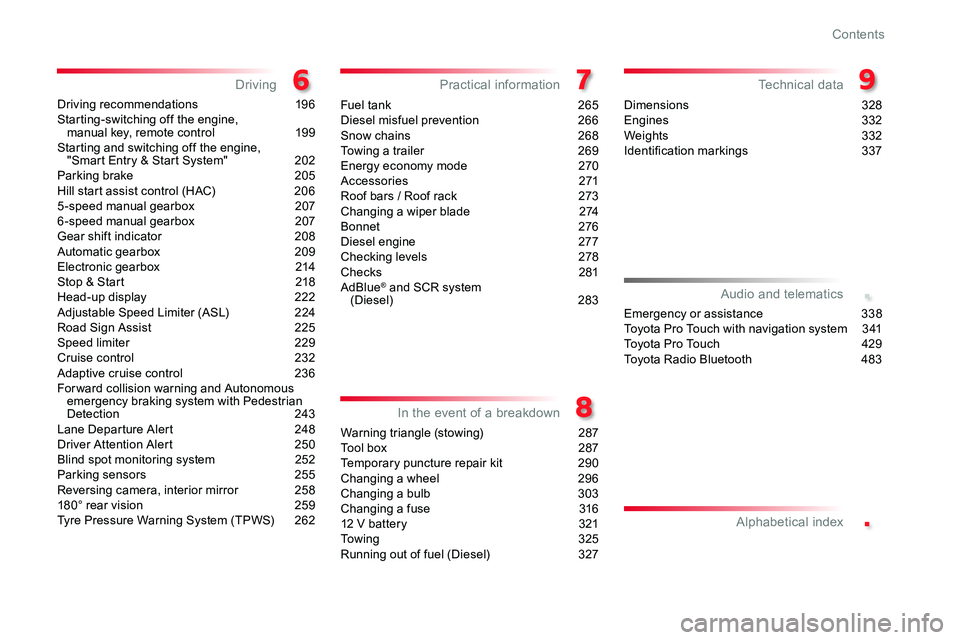
.
.
Driving recommendations 196Starting-switching off the engine, manual key, remote control 199Starting and switching off the engine, "Smart Entry & Start System" 202Parking brake 205Hill start assist control (HAC) 2065-speed manual gearbox 2076-speed manual gearbox 207Gear shift indicator 208Automatic gearbox 209Electronic gearbox 214Stop & Start 218Head-up display 222Adjustable Speed Limiter (ASL) 224Road Sign Assist 225Speed limiter 229Cruise control 232Adaptive cruise control 236For ward collision warning and Autonomous emergency braking system with Pedestrian Detection 243Lane Departure Alert 248Driver Attention Alert 250Blind spot monitoring system 252Parking sensors 255Reversing camera, interior mirror 258180° rear vision 259Tyre Pressure Warning System (TPWS) 262
Fuel tank 265Diesel misfuel prevention 266Snow chains 268Towing a trailer 269Energy economy mode 270Accessories 271Roof bars / Roof rack 273Changing a wiper blade 274Bonnet 276Diesel engine 277Checking levels 278Checks 281AdBlue® and SCR system (Diesel) 283
Warning triangle (stowing) 287Tool box 287Temporary puncture repair kit 290Changing a wheel 296Changing a bulb 303Changing a fuse 31612 V battery 321Towing 325Running out of fuel (Diesel) 327
Dimensions 328Engines 332Weights 332Identification markings 337
DrivingPractical information
In the event of a breakdown
Technical data
Emergency or assistance 338Toyota Pro Touch with navigation system 3 41To y o t a P r o To u c h 429Toyota Radio Bluetooth 483
Audio and telematics
Alphabetical index
Contents
Page 4 of 516

4
Exterior
Filler cap, fuel tank 265 -266Misfuel prevention 266-267Running out of Diesel fuel, priming 327
Tyre Pressure Warning System (TPWS) 262-264Tyres, pressures 263 -264, 337ESC programme 161-163ABS, EBFD 162DSC, ASR 163Toyota Traction Select 163, 164-165Snow chains 268
Front doors 74-75AdBlue® tank 283-286Tool box 287-289
Automatic illumination of headlamps 149Automatic headlamp dipping 153-154Direction indicators 148Manually adjusting the headlamp beam height 155Changing front bulbs 303-309Headlamp wash 158
Opening the bonnet 276
Key 47Key, remote control 47-54Changing the battery, reinitialisation 54Smart Entry & Start System 55 -71Changing the battery, reinitialisation 70Starting - switching off the engine, key, remote control 199 -201Starting - switching off the engine, Smart Entry & Start System 202-204Locking / unlocking from inside 72-73Alarm 95-97
Road Sign Assist 225 -228For ward collision warning 243 -245Autonomous emergency braking 243, 246 -248Driver Attention Alert 250-251
Changing a wiper blade 274Automatic wiping 157-158Front demisting, defrosting 132
Front foglamps 147, 309Daytime running lamps 149, 305Cornering lighting 152
Parking sensors 255-257Towing 325-326
Over view
Page 7 of 516
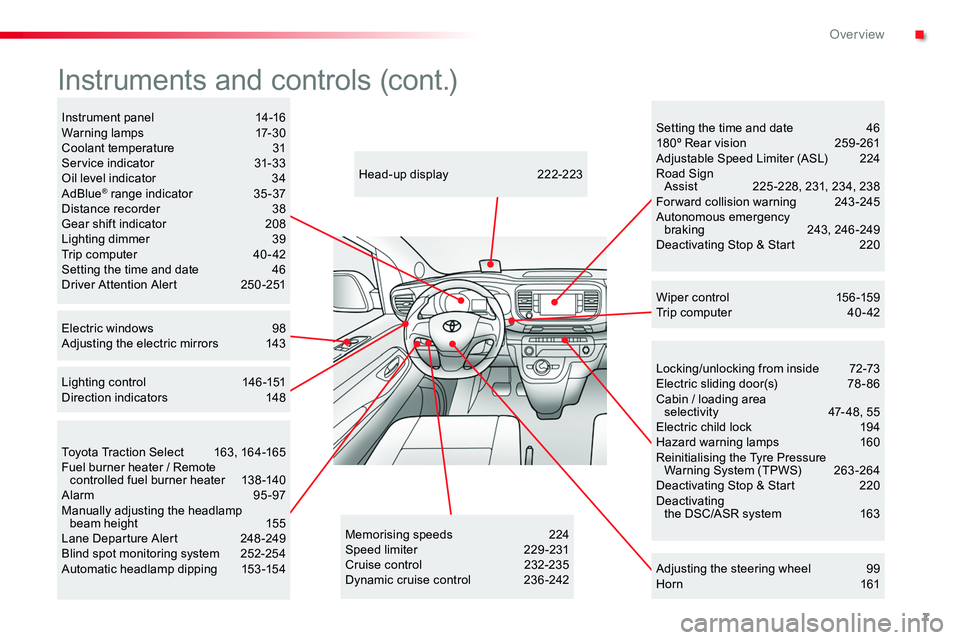
7
Locking/unlocking from inside 72-73Electric sliding door(s) 78 - 86Cabin / loading area selectivity 47-48, 55Electric child lock 194Hazard warning lamps 160Reinitialising the Tyre Pressure Warning System (TPWS) 263 -264Deactivating Stop & Start 220Deactivating the DSC/ASR system 163
Adjusting the steering wheel 99Horn 161
Head-up display 222-223
Instruments and controls (cont.)
Wiper c ontrol 15 6 -159Trip computer 40 - 42
Memorising speeds 224Speed limiter 229-231Cruise control 232-235Dynamic cruise control 236 -242
Instrument panel 14-16Warning lamps 17-30Coolant temperature 31Service indicator 31-33Oil level indicator 34AdBlue® range indicator 35 -37Distance recorder 38Gear shift indicator 208Lighting dimmer 39Trip computer 40 - 42Setting the time and date 46Driver Attention Alert 250-251
Electric windows 98Adjusting the electric mirrors 143
Toyota Traction Select 163, 164-165Fuel burner heater / Remote controlled fuel burner heater 138 -140Alarm 95-97Manually adjusting the headlamp beam height 155Lane Departure Alert 248 -249Blind spot monitoring system 252-254Automatic headlamp dipping 153-154
Setting the time and date 46180º Rear vision 259 -261Adjustable Speed Limiter (ASL) 224Road Sign Assist 225 -228, 231, 234, 238For ward collision warning 243 -245Autonomous emergency braking 243, 246 -249Deactivating Stop & Start 220
Lighting control 146-151Direction indicators 148
.
Over view
Page 13 of 516

13
Limit the causes of excess
consumption
Spread loads throughout the vehicle; place the heaviest items in the bottom of the boot, as close as possible to the rear seats.Limit the loads carried in the vehicle and reduce wind resistance (roof bars, roof rack, bicycle carrier, trailer...). Use a roof box in preference.Remove roof bars and roof racks after use.
At the end of winter, remove snow tyres and refit your summer tyres.
Observe the recommendations
on maintenance
Check the tyre pressures regularly, when cold, referring to the label in the door aperture, driver's side.Carry out this check in particular:- before a long journey,- at each change of season,- after a long period out of use.Don't forget the spare wheel and the tyres on any trailer or caravan.
Have your vehicle serviced regularly (engine oil, oil filter, air filter, passenger compartment filter...) and observe the schedule of operations recommended in the manufacturer's service schedule.
With a Diesel engine, if the SCR system is faulty your vehicle becomes polluting; go to an authorized Toyota dealer or repairer, or another duly qualified and equipped professional without delay to have the emissions of nitrogen oxides brought back to the legal level.
When refuelling, do not continue after the third cut-off of the nozzle to avoid any over flow.
At the wheel of your new vehicle, it is only after the first 1 800 miles (3 000 kilometres) that you will see the fuel consumption settle down to a consistent average.
.
Eco-driving
Page 22 of 516
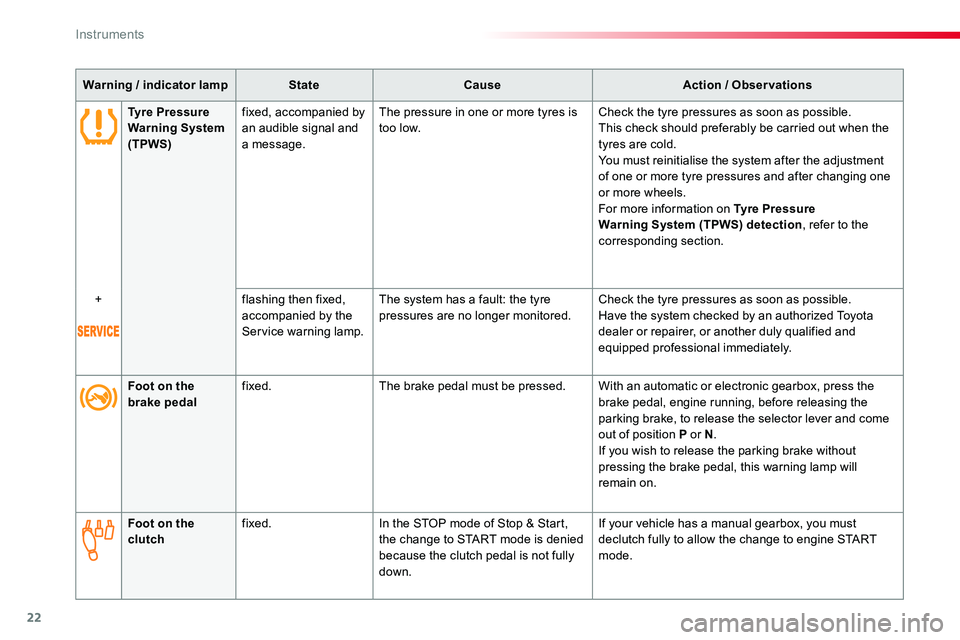
22
Warning / indicator lampStateCauseAction / Observations
Tyre Pressure Warning System (TPWS)
fixed, accompanied by an audible signal and a message.
The pressure in one or more tyres is too low.Check the tyre pressures as soon as possible.This check should preferably be carried out when the tyres are cold.You must reinitialise the system after the adjustment of one or more tyre pressures and after changing one or more wheels.For more information on Tyre Pressure Warning System (TPWS) detection, refer to the corresponding section.
+flashing then fixed, accompanied by the Service warning lamp.
The system has a fault: the tyre pressures are no longer monitored.Check the tyre pressures as soon as possible.Have the system checked by an authorized Toyota dealer or repairer, or another duly qualified and equipped professional immediately.
Foot on the brake pedalfixed.The brake pedal must be pressed.With an automatic or electronic gearbox, press the brake pedal, engine running, before releasing the parking brake, to release the selector lever and come out of position P or N.If you wish to release the parking brake without pressing the brake pedal, this warning lamp will remain on.
Foot on the clutchfixed.In the STOP mode of Stop & Start, the change to START mode is denied because the clutch pedal is not fully down.
If your vehicle has a manual gearbox, you must declutch fully to allow the change to engine START mode.
Instruments
Page 28 of 516
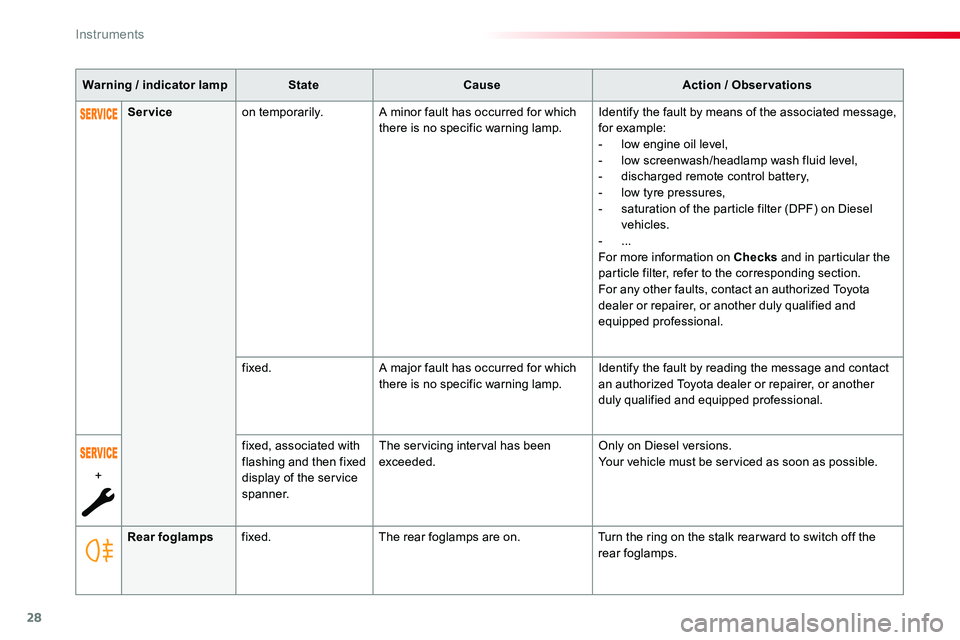
28
Warning / indicator lampStateCauseAction / Observations
Rear foglampsfixed.The rear foglamps are on.Turn the ring on the stalk rear ward to switch off the rear foglamps.
Serviceon temporarily.A minor fault has occurred for which there is no specific warning lamp.Identify the fault by means of the associated message, for example:- low engine oil level,- low screenwash/headlamp wash fluid level,- discharged remote control battery,- low tyre pressures,- saturation of the particle filter (DPF) on Diesel
vehicles.- ...For more information on Checks and in particular the particle filter, refer to the corresponding section.For any other faults, contact an authorized Toyota dealer or repairer, or another duly qualified and equipped professional.
fixed.A major fault has occurred for which there is no specific warning lamp.Identify the fault by reading the message and contact an authorized Toyota dealer or repairer, or another duly qualified and equipped professional.
+
fixed, associated with flashing and then fixed display of the service spanner.
The servicing interval has been exceeded.Only on Diesel versions.Your vehicle must be serviced as soon as possible.
Instruments
Page 44 of 516

44
Driving menu
The systems with settings that can be adjusted are detailed in the table below.For more information on a driving assistance system refer to the corresponding section.
ButtonCorresponding functionComments
Tyre Pressure Warning System (TPWS) initialisationReinitialisation of the Tyre Pressure Warning System (TPWS).
Blind spot monitoring systemActivation/Deactivation of the function.
Stop & Star t systemActivation/Deactivation of the function.
or
Lane Departure AlertActivation/Deactivation of the function.
Automatic headlamp dipActivation/Deactivation of the function.
Instruments
Page 162 of 516

162
Anti-lock braking system
(ABS) and electronic brake
force distribution (EBFD)
In emergency braking, press ver y firmly and maintain this pressure.
When changing wheels (tyres and rims), ensure that these are approved for your vehicle.Normal operation of the ABS may make itself felt by slight vibrations of the brake pedal.
The fixed illumination of this warning lamp indicates that there is a fault with the ABS.The vehicle retains conventional braking. Drive carefully at moderate speed.
When this warning lamp comes on, coupled with the STOP and ABS warning lamps, accompanied by an audible signal and a message, it indicates that there is a fault with the electronic brake force distribution (EBFD).You must stop as soon as it is safe to do so.In both cases, have the system checked by an authorized Toyota dealer or repairer, or another duly qualified and equipped professional as soon as possible.
Intelligent traction
control
If fitted to your vehicle, it has a system to help driving on snow: intelligent traction control.This system detects situations of difficult sur face adhesion that could make it difficult to move off or make progress on deep fresh snow or compacted snow.In these situations, intelligent traction control limits the amount of wheel slip to provide the best traction and trajectory control for your vehicle.
The use of snow tyres is strongly recommended on sur faces offering low levels of grip.
Safety
Page 197 of 516
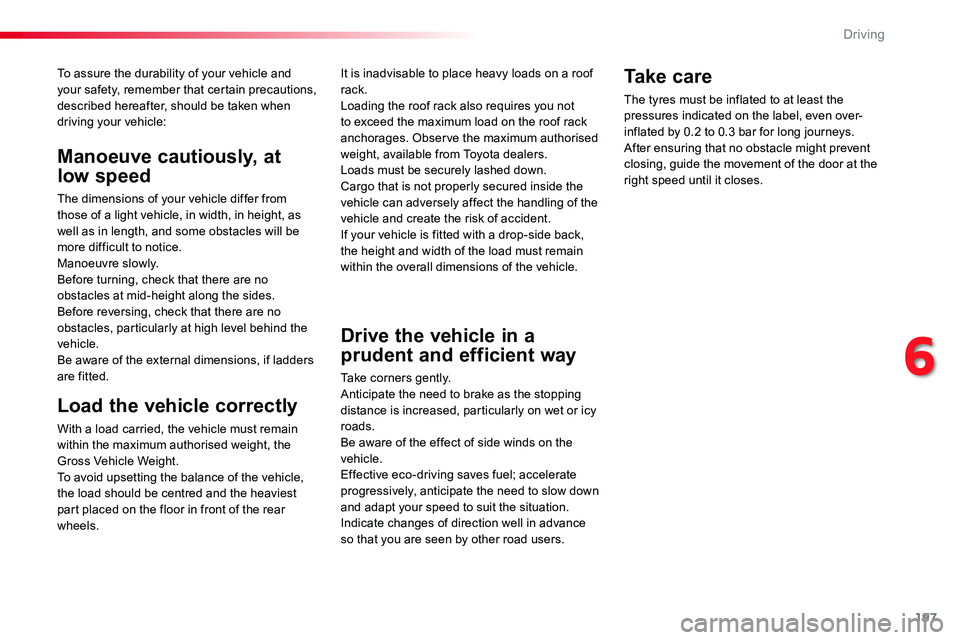
197
To assure the durability of your vehicle and your safety, remember that certain precautions, described hereafter, should be taken when driving your vehicle:
Load the vehicle correctly
With a load carried, the vehicle must remain within the maximum authorised weight, the Gross Vehicle Weight.To avoid upsetting the balance of the vehicle, the load should be centred and the heaviest part placed on the floor in front of the rear wheels.
Manoeuve cautiously, at
low speed
The dimensions of your vehicle differ from those of a light vehicle, in width, in height, as well as in length, and some obstacles will be more difficult to notice.Manoeuvre slowly.Before turning, check that there are no obstacles at mid-height along the sides.Before reversing, check that there are no obstacles, particularly at high level behind the vehicle.Be aware of the external dimensions, if ladders are fitted.
It is inadvisable to place heavy loads on a roof rack.Loading the roof rack also requires you not to exceed the maximum load on the roof rack anchorages. Observe the maximum authorised weight, available from Toyota dealers.Loads must be securely lashed down.Cargo that is not properly secured inside the vehicle can adversely affect the handling of the vehicle and create the risk of accident.If your vehicle is fitted with a drop-side back, the height and width of the load must remain within the overall dimensions of the vehicle.
Drive the vehicle in a
prudent and efficient way
Take corners gently.Anticipate the need to brake as the stopping distance is increased, particularly on wet or icy roads.Be aware of the effect of side winds on the vehicle.Effective eco-driving saves fuel; accelerate progressively, anticipate the need to slow down and adapt your speed to suit the situation.Indicate changes of direction well in advance
so that you are seen by other road users.
Take care
The tyres must be inflated to at least the pressures indicated on the label, even over-inflated by 0.2 to 0.3 bar for long journeys.After ensuring that no obstacle might prevent closing, guide the movement of the door at the right speed until it closes.
6
Driving
Page 198 of 516
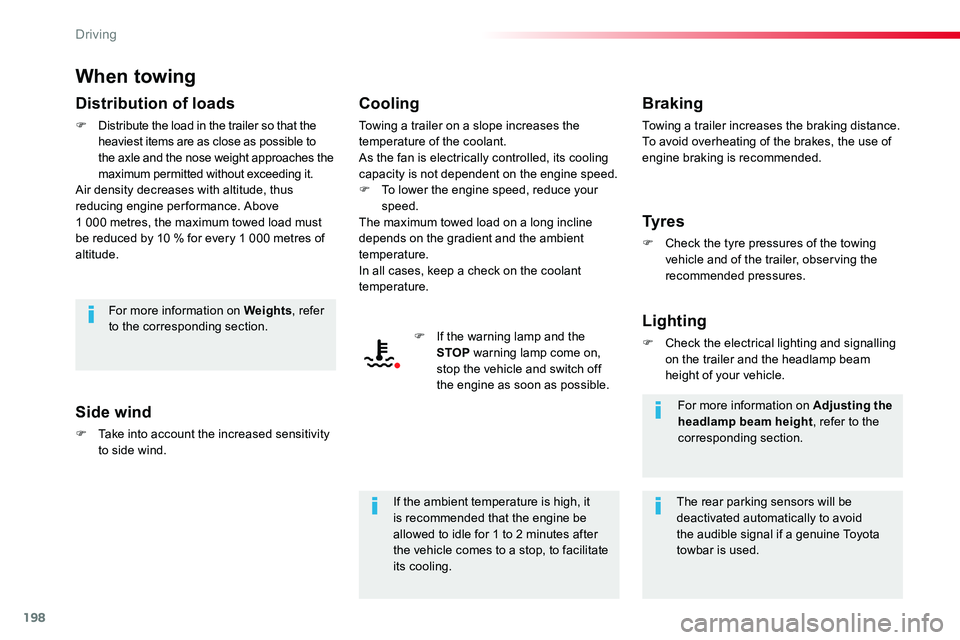
198
When towing
Distribution of loads
F Distribute the load in the trailer so that the heaviest items are as close as possible to the axle and the nose weight approaches the maximum permitted without exceeding it.Air density decreases with altitude, thus reducing engine performance. Above 1 000 metres, the maximum towed load must be reduced by 10 % for every 1 000 metres of altitude.
Side wind
F Take into account the increased sensitivity to side wind.
Cooling
Towing a trailer on a slope increases the temperature of the coolant.As the fan is electrically controlled, its cooling capacity is not dependent on the engine speed.F To lower the engine speed, reduce your speed.The maximum towed load on a long incline depends on the gradient and the ambient temperature.In all cases, keep a check on the coolant temperature.
F If the warning lamp and the STOP warning lamp come on, stop the vehicle and switch off the engine as soon as possible.
Braking
Towing a trailer increases the braking distance.To avoid overheating of the brakes, the use of engine braking is recommended.
Ty r e s
F Check the tyre pressures of the towing vehicle and of the trailer, observing the recommended pressures.
Lighting
F Check the electrical lighting and signalling on the trailer and the headlamp beam height of your vehicle.
For more information on Weights, refer to the corresponding section.
The rear parking sensors will be deactivated automatically to avoid the audible signal if a genuine Toyota towbar is used.
If the ambient temperature is high, it is recommended that the engine be allowed to idle for 1 to 2 minutes after the vehicle comes to a stop, to facilitate its cooling.
For more information on Adjusting the headlamp beam height, refer to the corresponding section.
Driving